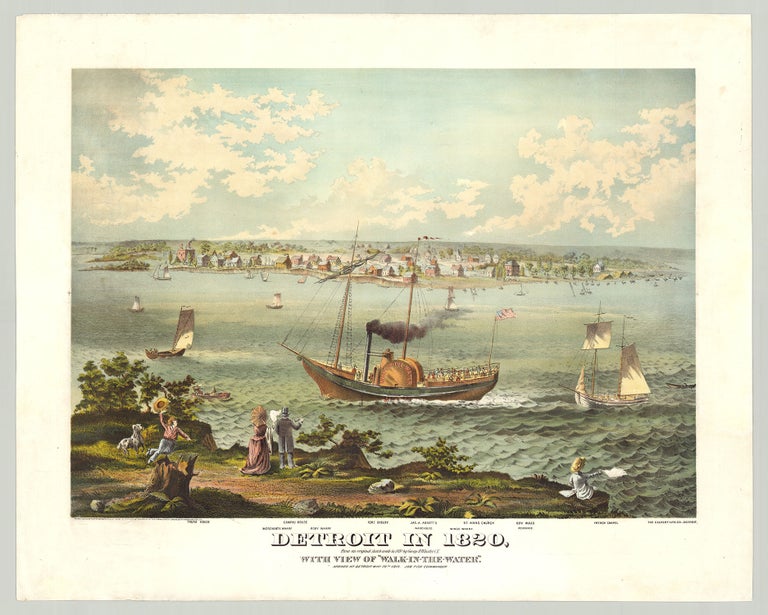Detroit in 1820, From an original sketch made in 1820 by George H. Whistler C. E. With View of “Walk -In-The-Water.” Arrived at Detroit May 20th 1819. Job Fish Commander.
Detroit: M. A Tryon, 1871. Chromolithograph, 17” x 23.75” plus margins. A lively and appealing view of a historic steamboat and the city of Detroit based on an eye-witness sketch executed in 1820 by civil engineer George H. Whistler. The celebrated steamboat Walk-in-the-Water is here depicted on the Detroit River, among a number of smaller vessels, the foreground showing the Canadian shoreline where several people have gathered along the river. In the background is the city of Detroit, comprising a number of notable buildings and structures, which are identified in the title margin. These include (from left to right) Truax House, Merchant's Wharf, Roby Wharf, Fort Shelby, Jas. A. Abbott's Warehouse, Wings Wharf, and so forth.
Walk-in-the-Water was built in Black Rock, New York in 1818, the pioneer of steamboat navigation on several of the Great Lakes and known to draw crowds of townspeople when it came ashore. A paddlewheel-driven boat 132’ long and 32’ wide with a smokestack 30’ high, its engine was described as having “a curious arrangement of levers with as many cogs as a grist-mill” (Musham, “Early Great Lakes Steamboats”). Fueled by wood—preferably “well-seasoned pine and hemlock split fine”—the vessel could travel up to 10 mph. Walk-in-the-Water's maiden voyage began at Buffalo on 25 Aug. 1818 with twenty-nine passengers en route to Erie, Grand River, Cleveland, Sandusky, and finally Detroit. She completed the entire trip in nine days, becoming the first steamboat to grace Lake Erie’s waters. Lacking enough power to make headway against the Niagara River’s strong currents, a team of twenty oxen was required to haul the vessel out of the river on the first part of the voyage. In her first season, she made seven trips to Detroit. Walk-in-the-Water could accommodate about 300 tons and over 100 passengers, and cost $18 for a cabin and $7 for steerage. It was outfitted with a smoking room, baggage room, and dining room. Following repairs after running aground near Erie in Sept. 1818, in 1819 she traveled to Mackinaw, Michigan via Lake Huron and then to Green Bay, Wisconsin—the first steamboat on both Lakes Huron and Michigan. Walk-in-the-Water was wrecked in 1821 in a storm near Buffalo while carrying a full cargo. While all passengers survived, the losses were estimated at $10,000-$12,000. While the origin of the ship’s name is uncertain, one theory is that it came from the exclamation “walks in the water,” made by a Native American upon seeing Robert Fulton's pioneering steamboat North River on the Hudson River in 1807.
The Calvert Lithographic Co. was founded in Detroit by the English-born Thomas Calvert (1828–1900) in 1864. By 1866, the company was employing color lithography to produce portraits, maps, advertising posters, labels, and landscape and city views. The firm would stay in business over the next century and became one of the foremost lithographers in the U.S., servicing tobacco companies and the Michigan seed industry. When the National Lithographers’ Association was founded in the late 1880s, Thomas Calvert became its vice-president. In 1950, the firm was sold to a group of Chicago investors and in 1970 was incorporated by the Canadian printing co., Lawson & Jones.
Another firm, Corrie’s Detroit Lithographic Office, published circa 1872 a hand-colored lithograph that appears to be a knock-off of the print offered here. The Calvert view is considerably more detailed, depicting quite a few more buildings in Detroit, among other differences.
REFERENCES: Reps 1750; Last, Jay T. The Color Explosion (Santa Ana, California: Hillcrest Press, 2005), pp. 50–53; Musham, H. A. “Early Great Lakes Steamboats: The Walk-in-the-Water,” The American Neptune (Salem, Mass.: The American Neptune, Inc., 1945), pp. 27–42; Palmer, Mary A. Witherell. The Wreck Of The Walk-in-the-Water, Pioneer Steamboat On The Western Lakes (Buffalo and Erie County Historical Society, 1865); Encyclopedia of Cleveland History, “Walk-in-the-Water” at case.edu
CONDITION: Very good, a few barely perceptible, expertly repaired tears into image with corresponding paper pulp reinforcement on verso, some toning in upper left corner of image.
Item #6044
Sold


